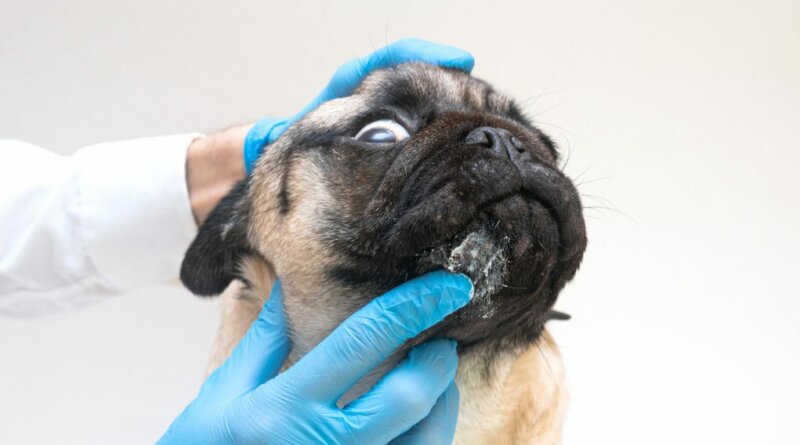10 Causes of Folliculitis in Dogs and How to Treat Them
Bacterial Folliculitis, or simply Folliculitis in dogs, is a hair follicle inflammation caused by either bacterial infection, parasitic infestations, hormonal disorders, fungi infections, systematic diseases, or skin diseases.
To prevent this condition from affecting your dogs, here’s what you need to know more about Bacterial Folliculitis in dogs.
Identifying Folliculitis in Dogs
Whatever the cause of the inflammation may be, the principal and most noticeable symptoms of canine folliculitis can be:
- Swelling
- Redness
- Itching
- Pustules (Pimples)
- Hair Loss
But you can also check for:
- Hyperpigmentation, or darkening of the skin;
- Superficial Erosions, or the loss of the outer lawyer of the skin, causing raw spots on the skin;
- Draining Tacts or Fistulous Tracts are large, firm, raised, and damaged circular tissues in between your dog’s skin;
- Papules are solid and elevated reddish swellings on the skin caused by inflammation;
- Epidermal Collarettes are circular areas of hair loss paired with crusting or scaling around their borders.
Aside from these symptoms, your dog’s veterinarian will also do several diagnostic tests such as skin scrapings, skin cytology, and fungal culture to determine whether they have Canine Folliculitis or not.
Other possible tests also include ringworm testing, skin biopsy, histopathology, and bacterial culture and sensitivity.
There are no specific breeds predisposed to having a hair follicle infection. However, some dog breeds can have skin diseases in general. They may also contract systematic diseases, like canine skin infection, that can eventually lead to folliculitis.
ALSO READ: Top 5 Best Itch Relief Treatments for Dogs
Causes and Treatments of Folliculitis in Dogs
The most common causes of folliculitis in dogs are skin diseases. Skin diseases originate from an overreactive immune system response to allergies or specific infectious or environmental agents.
As dogs instinctively scratch their skin, they will also produce tiny skin wounds that become infected with bacteria, leading to folliculitis or staph infection.
The nine most common skin conditions that may cause folliculitis in dogs, as well as proper treatment for them, are:
1. Callus Dermatitis
When a dog scratches and bites an affected area, it can create cracks in the skin. These cracks also provide the warm, dark, and moist regions that encourage bacterial growth.
Constant irritation forms calluses, most often found on their feet but may also be found on the chest, elbows, and hocks.
A callus may be possible protection of the skin. Still, where calluses reside, there can be the formation of small cysts around the hair follicles that may become irritated and cause bumps, blackheads, holes, or discharge on the callus.
Treatment: Vet diagnosis, antibiotics, and medicated shampoo for two to six weeks. Use soft bedding and maintain the dog at a healthy weight to reduce pressure placed upon the calluses.
2. External Parasites
Fleas are the most common external parasite found on dogs and can cause severe skin irritation when heavily infested. Other external parasites that cause skin irritation are ear mites, sarcoptic mange mites (scabies), ticks, and fleas.
Treatment: Maintaining a well-groomed coat and preventative maintenance schedule, flea and tick medications, and topical ointments. Mite-killing or flea-killing treatments may also be necessary to remove a current infestation before preventative maintenance can occur.
Additionally, it may be helpful to invest in inflammation, reducing ointment to relieve the dog of irritation.
3. Interdigital Cysts
An interdigital cyst is a painful lesion located in the interdigital webs of dogs, as described and defined by the Merck Veterinary Manual. Also known as interdigital furuncles, they’re noticeable as a sore or hairless bump between a dog’s toes.
They’re likely due to allergies, excess weight, poor foot conformations, mites, ingrown hairs, other foreign bodies, or yeast infections.
Treatment: Vet diagnosis, use of antibiotics/steroids/mite-killers, Epsom salt soaks, medicated cloths, or in dire situations, the removal of the webbing between their toes. A controversial procedure as it may cause problems of a different type.
4. Allergies
Skin allergies happen due to a state of over-reactivity of the dog’s immune system to an allergen. Allergens can be anything from food to grass to fleas.
If an allergic reaction is producing folliculitis, lookout for signs of itching, coughing, sneezing, runny eyes and nose, and sometimes vomiting and diarrhea.
Allergies are widespread in dogs, with no predisposition to a specific age, breed, or body type.
Treatment: Most allergies are treatable at home by identifying and removing the allergen from their vicinity or overall routine. If unavoidable or unidentifiable, the vet can prescribe allergy medication or recommend monthly allergy shots depending on the intensity and frequency of the reactions.
5. Canine Acne
This condition is similar to human acne prevalent in adolescent dogs, usually showing up at approximately 5-8 months of age.
They are red bumps and blackheads found on the chin and lips of younger dogs, and they can become infected. The affected areas may fill with pus causing the dog to scratch and increase the risk of bacterial infection in their skin.
Treatment: Acne is primarily an eyesore but can become an issue when infected. Thus, a vet can prescribe a canine acne treatment that is safe for use.
They may also recommend a change of diet and possibly a change in their bowl material, from plastic to ceramic or metal, along with cleaning them daily.
6. Fungal Infections
There are various fungal infections, but the most common is Blastomycosis, a frequent yeast-like fungal infection in male dogs. The fungus lives in decaying wood and soil and thrives in wet environments like riverbanks, lakes, and swamps.
Other conditions include ringworm and yeast infections.
Treatment: All types require a vet diagnosis, and most often, a biopsy or testing is done to determine the exact fungal infection. Misdiagnosis is extremely dangerous as some symptoms are identical to cancer, bacterial infections, or other fungal infections.
Depending on the type of fungal infection, the vet may prescribe a medicated bath, oral anti-fungal medications, and antiseptic drugs. They can also prescribe infusing nasal passages with liquid anti-fungal medicines.
Treatments vary in length, with some being only two-four weeks and others extending through months.
7. Skin Fold Pyoderma
A skin fold pyoderma is a bacterial skin infection on the surface or deep layers of the skin. It is due to Staphylococcus intermedius, a naturally occurring bacteria in the skin that causes contamination when the natural balance is disturbed.
Major problems are rare; this infection typically only causes slight discomfort in addition to folliculitis.
Treatment: Vet diagnosis, oral antibiotics, and medicated shampoo for two to six weeks.
8. Pyotraumatic Folliculitis
Also known as acute moist dermatitis or “hot spot,” it is a condition caused by self-inflicted trauma as an attempt to relieve pain in a particular area. They react and look like infections in the skin but are not actual skin infections.
Treatment: Vet diagnosis to determine an underlying cause for the reaction that may need medical attention. Otherwise, a combination of antibiotics and cleaning of the affected area with medicated shampoo and topical medication.
9. Acral Lick Granuloma
A minor sore spot on the skin agitated by the dog creates a skin lesion. These are due to a dog’s need to lick an area, forming new granulomas continually.
The skin becomes so profoundly affected that you can inspect the base layer of skin can and see scarred oil glands, inflamed capillaries, broken hair follicles, and pockets of bacteria.
Treatment: There is no specific treatment as this is self-inflicted by the dog without prior agitation. Even removal of the affected area is not a sufficient cure as the dog will do the same to the surgery spot.
Assisting the dog with anxiety or other similar issues may help as this can affect separation anxiety.
10. Malassezia Dermatitis
Malassezia Dermatitis results from an underlying skin disease caused by several skin diseases, especially Malassezia pachydermatis.
The affected areas are usually pink-ish and balding, with elephant-like skin. The skin also has yellow or gray spots; it’s either scaly, greasy, or waxy to the touch.
Treatment: The treatment for this condition usually includes using antifungal topical ointments and therapy, as well as antifungal shampoos, wipes, and lotions containing ketoconazole, fluconazole, itraconazole, or terbinafine.
Preventing Dog Folliculitis
The type of folliculitis is what determines how preventable it is. Keeping folds of skin on wrinkled dogs can help prevent it, as will maintaining stringent flea prevention.
Controlling hormonal imbalances and avoiding areas where the bacteria and fungus are prevalent can reduce the risk of folliculitis. Prevent itching in dogs using different methods and use an Elizabethan collar to stop the dog from licking/chewing at the area.
READ NEXT: 9 Ways to Improve Your Dog’s Skin and Coat Health
Related
















